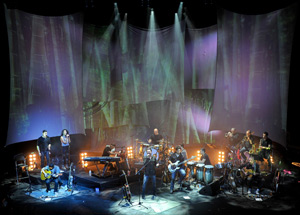
Juanes (singing lead at front-center) and his 12-piece touring band played to a packed house in mid-May at The Warfield in San Francisco.
Photo: Steve Jennings
After more than a decade of enjoying both commercial and critical success, Colombian singer/songwriter/musician Juanes continues to enthrall and energize his worldwide fan base while pursuing further evolution as an artist. His 2012 appearance on MTV Unplugged in Miami and live album Tr3s Presents Juanes: MTV Unplugged, produced by Juan Luis Guerra, took him into new musical territory. As Juanes told the Associated Press, “[MTV Unplugged] was a great opportunity to rediscover my songs and also to have all the freedom to do whatever I wanted to do with the songs. Actually, when I write my songs I always use my acoustic guitar. So for me this is kind of going back to my essence, to my roots, and reconnecting everything.”
The live album won a 2012 Grammy Award as Best Latin Pop Album and a 2012 Latin Grammy Award as Album of the Year. Juanes’ experience with MTV Unplugged inspired his 2012-2013 Loud and Unplugged tour of North America and Europe with a 12-piece band featuring a wide variety of instruments. Mix attended Juanes’ stop at the Warfield Theater in San Francisco in mid-May.
3G Productions, based in Las Vegas, provided the audio production and equipment rental for the 2013 North American tour. The tour’s veteran audio crew includes monitor tech/crew chief Jonathan Daly, front-of-house tech Manny Perez, system tech Clark Stewart, FOH engineer Jose Amable Frometa, and monitor engineer Anselmo Rota. “For the U.S. tour we’re carrying full production,” Daly says, which includes DiGiCo SD 10 consoles at both FOH and monitors, a d&b audiotechnik P.A., Dolby Lake Processor, Summit Audio DCL-200 compressor, Radial DI boxes for stringed instruments and keyboards, and mics from Shure, DPA, Sennheiser and Audix.
“Pretty much all of the instrumentation is acoustic,” Daly says, excepting bass and keyboards. “There are no amplifiers onstage, at all. A lot of the songs were retooled to fit the acoustic profile. But it’s still loud! [Laughs.] I mean, not very loud! There are still a lot of dynamics.”
Frometa, whose credits include Marc Anthony, began working with Guerra in the early 1990s, and it was Guerra’s manager who connected Frometa to Juanes as FOH engineer nearly 18 months ago. “I have only toured with this [13-piece band] configuration,” Frometa says, “but I can tell you a lot has changed [from Juanes’ previous tours]. Before it was all electric guitars; now, it’s all acoustics. The drum kit went from nine or 10 pieces to a 3-piece set—a 24-inch kick, snare, and 18-inch floor tom—and horns were added.”

Front-of-house engineer José Amable Frometa
Juanes sings into a Shure KSM 9, and Frometa says, “the goal with [Juanes’] vocal is to make it clear but not loud. Juanes himself doesn’t like the feeling if his voice is loud in the mix, so I keep it simple. The Summit insert gives me the coloration and compression. I use a short bright reverb and couple of delays with manual tap. Guitars are right behind Juanes’ vocal in the mix. They are also slightly panned. I use the thicker preset and a bright room with short decay from the DiGiCo effects library. Each 6-string guitar gets a DiGiTuBe [circuit that emulates the non-linearities of a tube amplifier] and graphic EQ inserted.
“The preamps on the SD Series are great,” Frometa continues. “The boards put out a very clean sound with an outstanding image. I use very little EQ—mostly high- and lowpass filters. DiGiTuBes are a nice feature. I created a fader/mute snapshot for each song. Dynamic EQ and compression are the features that help me the most in keeping up with the coloration changes from the guitars. Macros are another function I use a lot. It’s nice to be able to recall a window or toggle between settings in one channel with the touch of a button. The 4-page section with 10 assignable LED Macro buttons makes navigating the board a lot faster.”

Monitor engineer Anselmo Rota
Photo: Steve Jennings
On this tour, Frometa notes, “The mix structure is what’s most affected by venue size; some nights the guitars will need an extra push to find the desired balance. In most of these mid-sized to small venues, direct sound becomes a heavy part of the mix, so I use delays on drums and percussion to closely match the P.A. sound. Some nights the stage is just wide enough to accommodate the band, and the P.A. gets stacked right on each side, barely three feet away from [stage-] left and right guitar players, so every acoustic stringed instrument gets a graphic EQ inserted.”
For the P.A. system, 3G Productions spec’d a d&b audiotechnik rig comprising 12 V8s and four V12s per side, six J Series subwoofers per side, and eight Q10s for side hangs per side with four Q1s for front fills. “The ease of the rigging and the lightness of the box makes it a super-easy rig to fly,” Perez says. “I was blown away by the clarity and volume of the little box. More surprising is that it is a passive box. Whether we have all 16 boxes in an amphitheater or a small arena, or a small theater with just eight or 10 boxes, the SPL and sonic clarity is the same. The rig changes day to day since the venues are all different, but until now the Vs have been nothing but workhorses in terms of adapting to fit each venue.”
Rota, who has toured with Juanes previously, also uses the SD 10’s onboard feature set exclusively, including multiband compressors and DiGiTuBes, to handle the band’s 22 channels of IEMs—16 stereo mixes and eight mono outputs for effects. Daly notes that drummer Waldo Madera and bassist Pedro Felipe Navia use d&b M2 monitor wedges. “We’re using eight reverbs,” Daly adds. “Everybody has a full-on front-of-house mix, pretty much.”





